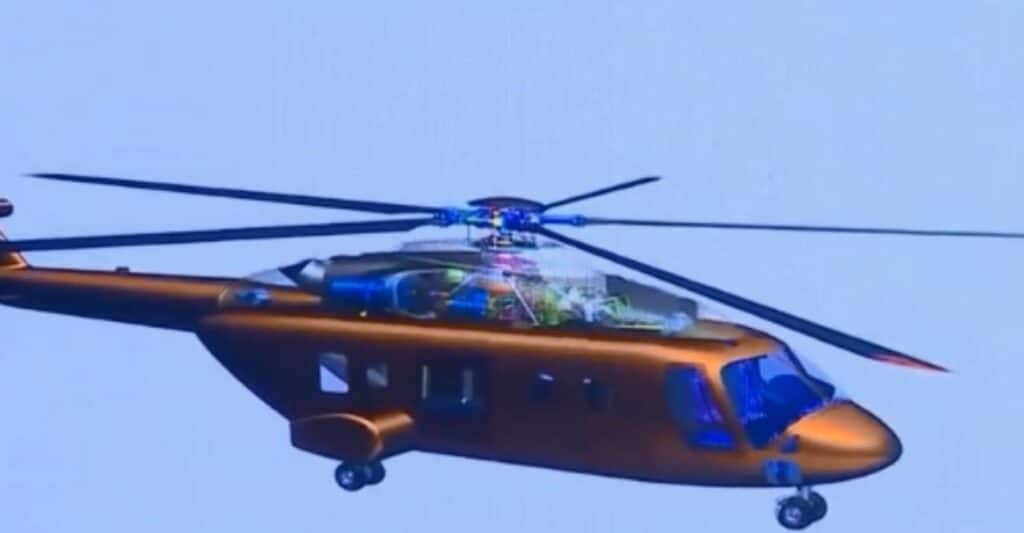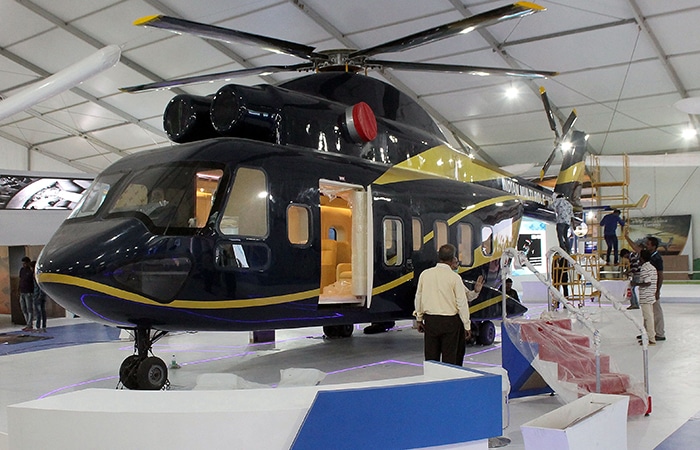Aerospace
Meet India’s first 13-tonne multirole defense helicopter.

The Indian aerospace sector is gaining international attention. Recently, Indian helicopter fighter jets demonstrated incredible performance at various airshows, demonstrating the strength of the aircraft’s manufacturing and supply.
With the introduction of the IMRH, HAL will expand its Helicopter Product offerings from 03 Ton to 13 Ton weight class, as well as address India’s requirement to replace the ageing Mi-17 helicopters, which are due for replacement progressively beginning in 2028. HAL intends to target the global helicopter market by benchmarking the proposed IMRH against its current helicopters, which include the Mi-17, S-92, AW-101, NH-90, and EC-725.
The Rotory wing R and D center played an important role in the Indian aerospace sector. The HAL Journey of building helicopters began in 1965 with the introduction of the Chetak, and by 1970, with the assistance of France Aérospatiale as a licensee, the Cheetah helicopter was built.
Further, in 2002, It introduced the ALH Dhru, and in 2013, it introduced the ALH Rudra, and in 2017, it launched the Light Combat Helicopter, and in 2019, it launched the Light Utility Helicopter, and now it is planning to build the 13 tonne weighing multirole helicopter. which is set to replace the air force’s MI-17 helicopter
[the_ad_placement id=”content”]
HAL’s rotory wings design and research Centre in Bangalore designed and developed the helicopter. In the beginning, three prototypes will be created: one for the structural test specimen and one for the ground test vehicle. Certifications are expected 7 years after the project is sanctioned.
HAL’s Rotory wings R & D center in Bangalore designed and developed the helicopter. In the beginning, three prototypes will be created: one for the structural test specimen and one for the ground test vehicle. Certifications are expected 7 years after the project is sanctioned.
HAL has already constructed a mechanism system, an air frame, blades, and a slew of other component-designed 3D concept parts that are fitted into the concept mhttps://jetlinemarvel.net/indian-air-force-jets-5000-sorties-72-hours-western-front/odel. It is a Utility and Armed variant designed for unrivalled performance at high altitude for the Indian air force and army.

Rotor Mechanism, Shri Syam Nath G, Chief Designer (Projects) explains about project at Aero India 2021
The navalized version will also have a longer range and a greater payload capacity. HAL estimates that over 314 rotocraft of the same class will be required to replace the existing Mil Mi-17 helicopters in service in India.

Cockpit instrument panel, Shri Syam Nath G, Chief Designer (Projects) explains about project at Aero India 2021
The helicopter is expected to have a maximum take-off weight of up to 14.2 tonnes and a crew of 24 to 36 people in various configurations. The helicopter will have a two-bladed tail rotor and a five-bladed main rotor with a diameter of 21.2 metres. MRH will be made up of 75% domestic content but will be powered by an imported 2000kW turboshaft engine. At sea level, the payload capacity will be 4 tonnes, and at 13,000 feet, it will be 1.5 tonnes. The aircraft will have two weapons wings with four hard points for up to 1,600 kilograms of armament. two inboard for a total loading capacity of 500 kg and two outboard for a total loading capacity of 300 kg. It can reach a top speed of 260 km/h.

Wind Tunnel testing, Shri Syam Nath G, Chief Designer (Projects) explains about project at Aero India 2021
The aircraft has completed the preliminary design phase and is expected to be approved for further development in early 2022. The first flight is scheduled for four years after the development project began, with the introduction scheduled for 2028-29.
[the_ad_placement id=”adsense-in-feed”]
Specifications.
- It comes up with 5 blades. it has 19.83 fuselage Length and width will be 2.70 meter and fuselage height is around 2.41. further the width including with rotor is 4.74 meter.
- Max take of weight is 13 tons,
- Max permissible take off weight 14.2 tons,
- Service ceiling is 6500 meter means up to 21325.46 feet.
- HOGE ceiling 4500 meter,
- It has 2000 kg of internal fuel tank endurance for 3 hours,
- It has 24 seats for default configurations and high density is up to 36 troops it can carry for mission.
- It has 260 km/h cruise speed.
- it can carry 4000 kg of payload at sea level.
- weapons station has 4 hard points inboard has two 500 kg loading and outboard two is for 300 kg loading capacity.
- It has two engines which combine produces 2000 kW of the power.
- it has 800 km of the range and which can have the 3 hours of the flight endurance.
- Rotor dia is around 21.2 meter.
[the_ad id=”11602″]
The HAL is currently releasing a global tender for the component requirements for the new Multipurpose helicopter. Keeping in mind that the government encourages and invites local suppliers to take on the design and construction of HAL components.

Final schematic design of IMRH , Shri Syam Nath G, Chief Designer (Projects) explains about project at Aero India 2021
HAL has already constructed the rotor system’s component mechanism. It has undergone virtual stress analysis with the aid of software, and it has a transmission system or gearbox that weighs one tonne and is built in bulk using die casting techniques.
HAL is looking for a special engine for the helicopter that can generate 2000 kw of power. As a result, once the project begins, the design suitability in the air frame will be updated to OEM during the prototypes.
Typically, few medium helicopters do not have retractable landing gear built into the airframe, but the HAL already has retractable and non-retractable try cycle landing gears.
[the_ad_group id=”4059″]
The Tricycle has fixed crashworthy wheel landing gear, passive steering, and a nose wheel lock, as well as a hydraulic wheel brake with a parking brake.
It has two electric power generators and an auxiliary power unit that can restart the power supply in the event of an emergency. Even HAL claims that the battery will provide backup power for the helicopter’s other functions during the 30-minute flight during emergency.
A broad overview of proposed airborne equipment and sensors was presented, emphasising the opportunities for private sector participation in the proposed IMRH programme, which will pave the way for India’s self-reliance, in line with the Government of India’s initiative of Aatmanirbhar Bharat Abhiyaan.
PM Modi hands over made-in-India light combat helicopters to IAF
There are already a few medium lift helicopters in service around the world, such as the Russian MI17, which has a capacity of 13 tonnes, the Sikorsky S-92, which has a capacity of 12.9 tonnes, the August Westland 101, which has a capacity of 15.6 tonnes, the NH90, which has a capacity of 10.6 tonnes, and the EC 725 eurocopter, which has a capacity of 11.2 tonnes. Indian multirole will be one of the future sources of additional support for Indian defence.
[the_ad_placement id=”article-ad”]
Taking into account the ministry’s approval of the project. The first flight is expected to take place within four years, and the operation clearance is valid for six years. If the project begins in 2022, HAL will likely phase out legacy MLH by 2029.
Rostec Started Flight Tests of the Upgraded Ka-32A11M Fire-fighting Helicopter
Furthermore, this helicopter can be used for a variety of purposes, including cargo transport, ground vehicle transport, VIP transport, and many others. Once this helicopter is inducted, HAL will become a major Aerospace market key player in the Asia region, building helicopters ranging in size from 3 to 13 tonnes. This will be another victory for the Indian aviation industry.
HAL signs contract with Mauritius for export of advanced light helicopters
[the_ad_group id=”4060″]
India is already developing its own light and medium fighter jets with 5.5 generation features, as well as commercial aircraft Dornier 228 and In associated with Airbus building C295.
Is India planning to purchase more Chinook helicopters?
What do you think of India’s new Multirole Helicopter? Please share your thoughts in the comments section below.
#HAL: #IMRH #IndianAirForce #MODindia

Aerospace
When Ratan Tata was denied entry to the airfield at the Aero India show, he waited

During our visit to Aero India 2019, we had the unexpected opportunity to see Ratan Tata at the event, which was a thrilling moment for us. However, there was a surprising hiccup when the security staff didn’t allow him to enter due to a lack of a security pass.
Despite this, he remained calm and patiently waited for about 20 minutes until a member of the Tata team brought him the required pass, after which he calmly proceeded inside. It was a humbling sight, showcasing his composed demeanor even in such situations.
Ratan Tata ji is not only a renowned industrialist but also a trained pilot, holding a pilot’s license. In 2007, he became the first Indian civilian to fly the F-16 Falcon during the Aero India show in Bangalore—a proud moment for the nation.
His passion for aviation extended beyond flying, as he played a key role in shaping India’s aerospace industry. Under his leadership, Tata ventured into manufacturing and maintaining aerospace components while upholding its legacy of quality. Notably, Tata’s collaboration with Airbus to develop and manufacture the C295 aircraft is a testament to its growing influence in the sector.
-

 Aviation2 months ago
Aviation2 months agoMicrosoft Flight Simulator Raises $3 Million to Bring Back the An-225 Mriya
-

 Airlines2 months ago
Airlines2 months agoQatar Citizens Can Travel to the United States Without a Visa
-

 Aviation2 months ago
Aviation2 months agoQatar Airways bans these new Electronic Devices on plane
-

 Defence2 months ago
Defence2 months agoWhich Country Has the Largest Fleet of Fighter Aircraft?
-

 Airlines7 days ago
Airlines7 days agoDAMAC Air: Dubai’s New Luxury Airline Offers Free Flights for Registration
-

 Airport2 months ago
Airport2 months agoWestern Sydney Airport Welcomes Its First Plane After 6 Years of construction
-

 Airlines6 days ago
Airlines6 days agoAir India to Launch aircraft maintenance training institute in Bengaluru
-

 Aviation2 months ago
Aviation2 months agoDid you know ? Once Boeing 747 carried 1088 passenger in 1991












